Bible › Black Figure Pottery › Regolini-Galassi Tomb » Origins and History
Articles and Definitions › Contents
- Bible › Origins
- Black Figure Pottery › Origins
- Regolini-Galassi Tomb › Origins
Ancient civilizations › Historical places, and their characters
Bible › Origins
Definition and Origins
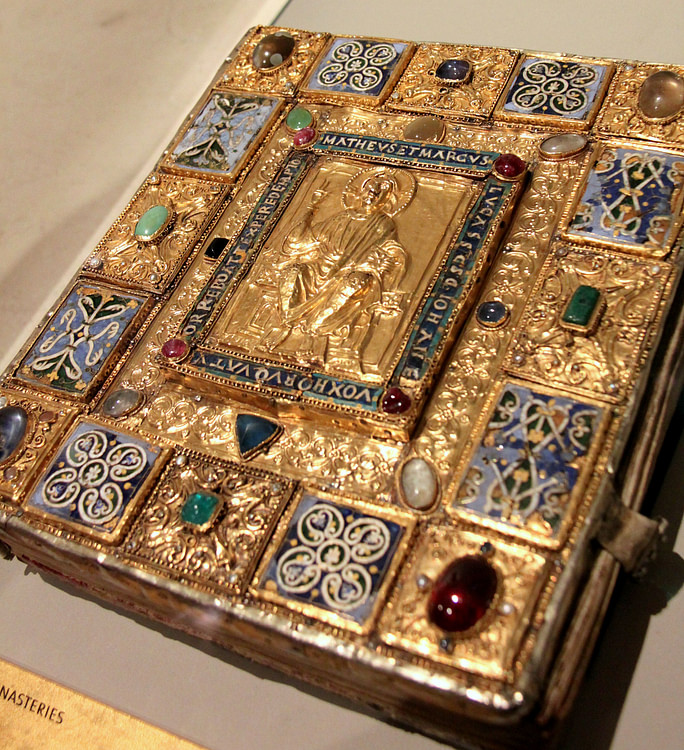
The Bible takes its name from the Latin Biblia (book or books) which comes from the Greek Ta Biblia (the books) traced to the Phoenician port city of Gebal, known as Byblos to the Greeks. Writing and books became associated with Byblos because it was an exporter of papyrus used in writing)and the Greek name for papyrus was bublos, linking the city with the written word.Although the Bible is often considered a single, cohesive, work, it is actually an anthology of ancient writings by many different authors over many centuries which were collected in a single book. The Bible contains works of poetry, religious-themed narratives, philosophical musings such as The Book of Ecclesiastes, epistles, and the apocalyptic masterpiece known as The Book of Revelation.
The common thread all these collected works have in common is the existence of an all-powerful deity who is the creator of the universe and has an interest in the personal lives and final fate of human beings. The books of the Christian Bible were arranged in the sequence one finds them in today to tell the story of the creation of the world by a supreme deity, the fall of man from paradise, and humanity's redemption by the Son of God but these books were not written in that sequence nor would the original authors of the Old Testament works have had that particular story in mind. The Bible of Judaism (collected and authorized by c. 3rd century BCE) contains the Torah (the first five books of the Bible) and the Tanakh (the stories of the judges and prophets) and makes no mention of Jesus Christ. The God of the Bible in these works is the God of Judaism - a single all-powerful deity - and, prior to the approptiation of Hebrew scriptures by early Christianity, the stories which made up the Bible told the story of God's care for and intervention in the affairs of the Israelites of the Middle East.
STRUCTURE OF THE BIBLE
In Judaism the scriptures are called the Tanakh and are recognized as comprising twenty-four books divided into three categories: The Pentateuch (or Teachings of the Five Books of Moses ) The Prophets, and The Writings. Christianity, which appropriated the Tanakh and claimed it as their own early theological history, call it the Old Testament. Early Christian writers, years after the probable date of the death of Jesus, penned the gospels and The Book of Acts. Paul the Apostle wrote most of the epistles which make up the twenty-seven books of the Christian New Testament and whose theology informs the gospels. The Book of Revelation, attributed to John of Patmos, is the last book of the Christian Bible.
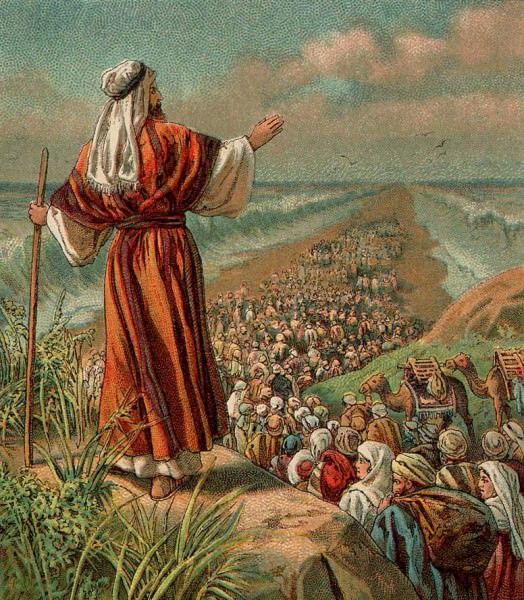
Moses & the Parting of the Red Sea
BRIEF SYNOPSIS & COMMENTARY
The book of Genesis, the first book of the Old Testament, tells the story of the creation of the universe, the world, and humanity, the fall of man in the Garden of Eden, and the great flood which God sent on the world because of the evil of mankind. Following the flood, Noah's children re-populate the earth and the narrative then follows the stories of his descendents who are the Hebrew ancestors of the men who wrote the stories. The tale of Joseph and his coat of many colors brings the Hebrews from their land of Canaan to Egypt where, the Book of Exodus explains, they became slaves. They were led from Egypt to freedom by the great lawgiver Moses who then passed his leadership to his second-in-command Joshua son of Nun whose army lay waste to the region of Canaan so the Hebrews could claim it as the land promised to them by their God (as told in the Books of Joshua and Numbers). Following the establishment of the people who called themselves Israelites in the land, famous kings such as David and his son Solomon ruled and great prophets such as Jeremiah and Isaiah, Ezekial and Jonah preached the will of their God.
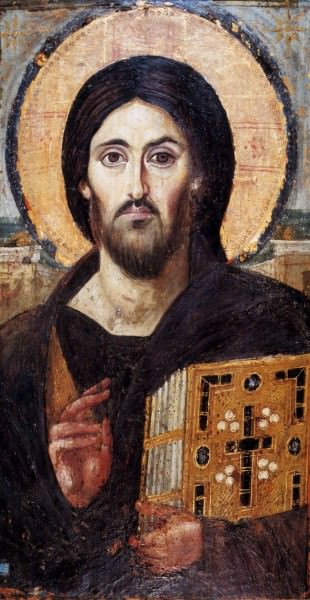
Jesus Christ
The New Testament focuses on the life and teaching of Jesus Christ, the son of God sent to redeem humanity from sin. Jesus is born of the virgin Mary and begins his ministry, preaching a direct and personal relationship with God, when he is about thirty years old. He is betrayed by one of his followers and crucified by the Romans for inciting sedition. Three days after his death, he rises from the grave and acends to heaven to rule at the right hand of God the father. In his place, he sends the Holy Spirit who will henceforth minister to believers on earth. The New Testament ends with the vision of the end of the world as told by John of Patmos.
The first four books (Matthew, Mark, Luke, and John) are often believed to be eye-witness accounts of Jesus' ministry on earth but are not. The practice of writing under a famous person's name or, at least, attributing what one had written to someone better known, was well established at the time the gospels were written and it is probable that the authors chose the names of people who were already well respected in the Christian community to gain a wider acceptance of the material. Because the gospels come before the Book of Acts and the Letters of Paul in the New Testament many people seem to believe that these works were written first and the events they relate happened earlier than the later books; actually, the reverse is true. The letters of Paul came first and the gospels were written later.
THE STORIES WHICH THE BIBLE RELATES WERE CONSIDERED TO BE HISTORICALLY ACCURATE & UNIQUE UNTIL THE 19TH CENTURY CE WHEN ARCHAEOLOGISTS DISCOVERED THE CIVILIZATIONS OF MESOPOTAMIA & EGYPT.
Between 42-62 CE the apostle Paul traveled throughout the Mediterranean on his evangelical missions preaching the new religion of the risen Christ. The Bible itself in the Book of Acts and I Peter allude to the possibility, explored in depth in the late 19th and early 20th century, that Paul's version of Christianity was different from the message preached by Jesus of Nazareth. Paul (formerly Saul) of Tarsus was a Jewish pharisee of Tarsus (in modern day Syria ) who claimed to have received a vision from God which convinced him of the reality of Jesus Christ as the risen son of the creator of the universe sent to earth to die for the sins of man. While many people have since considered this a miraculous occurrence which displays God's love for humanity through the sacrifice of his son, the concept of the dying and reviving god figure was well known in Paul's time and it is probable that beliefs such as the Cult of Isis informed the basis of Paul's religious views. The understanding of the Bible between the time of Constantine 's elevation of Christianity to the religion of Rome (4th century CE) and the next few hundred years was relatively unchanged but, in the 19th century CE, biblical interpretation underwent a radical reformation.
BIBLICAL UNDERSTANDING & 19TH CENTURY ARCHAEOLOGY
The stories which the Bible relates were considered to be historically accurate and entirely unique until the mid 19th century CE when archaeologists discovered the civilizations of Mesopotamia and Egypt. The Bible, in fact, was considered the oldest book in the world until much older literature was discovered which told the same stories, in an earlier form, than those found in the Bible. Scholars had long known that the Bible was a compilation which had been gathered from earlier works and authorized under the Bishops of Rome but no one seemed to be aware that those works were drawn from even earlier pieces.No one could read Egyptian hieroglyphics until Jean Jacques Champollion (1790-1832 CE) deciphered them and the literature of Sumer was completely unknown to the modern world.

Model of Herod's Renovation of the Temple of Jerusalem
In the mid-19th century CE museums and publications sent archaeologists from the west to the region of Mesopotamia to find physical evidence which would substantiate biblical narratives. The 19th century CE was an interesting period for religion in the west, especially Christianity, in that people became more vocal in their criticism of the faith and new ideas and philosophies provided for acceptable alternatives to religious belief. Charles Darwin's On the Origin of Species By Means of Natural Selection was published in 1859 CE and challenged the traditionally held belief in the creation of humanity by an all powerful God. The Bible claimed that God had made man "a little lower than the angels"(Psalm 8:5) while Darwin was claiming humans evolved from lower species. In 1882 CE the German philosopher Nietzsche published his work The Gay Science which famously argued "God is Dead - and we have killed him." Nietzsche's line is almost always taken out of context as a defiant repudiation of religion but, actually, he was only saying that advances in technology and knowledge throughout the 19th century had rendered the concept of God obsolete. Partly in response to such claims, museums and predominantly Christian societies in the west sent these teams of archaeologists to Mesopotamia to find hard evidence of the truth of the Bible.
What they found instead was the ancient civilization of Mesopotamia and the rich literary heritage which had been buried under the sands for centuries. Iconic stories such as the Fall of Man and the Great Flood, they found, were not unique to the Bible at all but had already been written down centuries before the Hebrew scribes revised them in their own work. The great law code of Moses, thought to be the first in history, was discovered to have had a predecessor in the Law Code of Ur-Nammuand the more famous Code of Hammurabi.
Excavations in Egypt, meanwhile, found no evidence for the story of the enslavement of the Hebrews under the pharaoh of Egypt nor any for the other details found in the Book of Exodus. Once ancient Egyptian hieroglyphics were able to be read, the myths of Egypt were found to have similarities to the Christian figure of the dying and reviving god and Mary, the mother of Jesus, to have taken on many of the attributes and epithets of the Egyptian goddess Isis. As stories of these discoveries became more widely known, belief in the Bible as the word of God began to change to an understanding of the work as inspired by God or as scripture written by inspired men.
CONCLUSION
Although many people throughout the world today continue to believe in the Bible as the authoritative word of God, this belief is not as widespread as it was prior to the 19th century CE. The interpretation of the Bible in the present day is largely a matter of individual understanding without the societal expectation which informed western society prior to the work of scholars, archaeologists, and historians in the 19th century CE. These individuals changed the world by radically revising people's understanding of history and the Bible and opening up avenues of inquiry which greatly broadened human knowledge. The revised understanding of the Bible and its place in history upset many people at the time and continues to in the modern day but, to many others, the beauty of the Bible's language and the grand vision of redemption it presents is undiminished by the revisionist revelations of the 19th century CE. The Bible continues to inspire and encourage people around the world, translated into every language, and remains the best-selling book of all time.
Black Figure Pottery › Origins
Definition and Origins
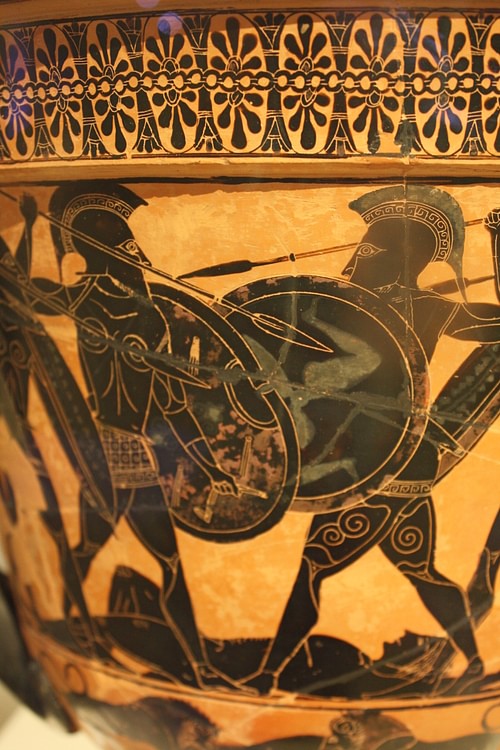
Ancient Greek black-figure pottery (named after the colour of the depictions on the pottery ) was first produced in Corinth c.700 BCE and then adopted by pottery painters in Attica, where it would become the dominant decorative style from 625 BCE and allow Athens to dominate the Mediterranean pottery market for the next 150 years. Laconia was a third, albeit minor, producer of the style in the first half of the 6th century BCE. The more than 20,000 surviving black figure vessels make it possible not only to identify artists and studios, but they also provide the oldest and most diverse representations of Greek mythology, religious, social, and sporting practices. The pottery vessels are also an important tool in determining the chronology of ancient Greece.
DEVELOPMENT
Evolving from the earlier geometric designs on pottery, the black-figure technique depicted animals (more favoured in Corinth) and human silhouette figures (preferred in Athens) in naturalistic detail. Before firing, a brilliant black pigment of potash, iron clay, and vinegar (as a fixative) was thickly applied to vases and gave a slight relief effect. Additional details such as muscles and hair were added to the figures using a sharp instrument to incise through the black to reveal the clay vessel beneath and by adding touches of red and white paint. Vessel borders and edges were often decorated with floral, lotus, and palmette designs.
CERTAIN COLOUR CONVENTIONS WERE ADOPTED SUCH AS WHITE FOR FEMALE FLESH, BLACK FOR MALE.
BLACK-FIGURE CONVENTIONS
Certain colour conventions were adopted such as white for female flesh, black for male. Other conventions were an almond shape for women's eyes, circular for males, children are as adults but on a smaller scale, young men are beardless, old men have white hair and sometimes stoop, and older women are fuller-figured. Some gestures also became conventional such as the hand to the head to represent grief. Another striking feature of the style is the lack of literal naturalism. Figures are often depicted with a profile face and frontal body, and runners are in the impossible position of both left (or right) arms and legs moving forward. There was, however, some attempt at achieving perspective, frontal views of horses and chariots being especially popular.
Typical vessels of the style are amphorae, lekythoi (handled bottles), kylixes (stemmed drinking cups), plain cups, pyxides(lidded boxes), and bowls.
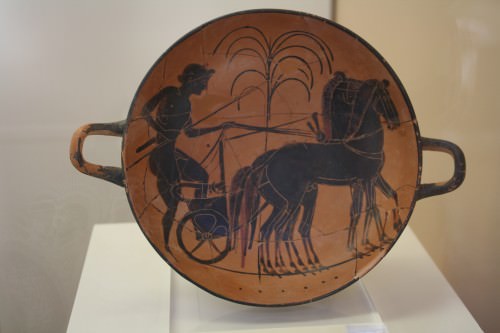
Greek Chariot
Painters and potters were usually, although not always, separate specialists. The first signed vase was by Sophilos and dates to c. 570 BCE. Many other individual painters have been identified with certainty through their signatures (most commonly as '...made this') and many more unsigned artists may be recognised through their particular style.
Perhaps the most celebrated example of the technique is the Francois Vase, a large volute krater, by Kleitias (c. 570 BCE) which is 66 cm high and covered in 270 human and animal figures depicting an astonishing range of scenes and characters from Greek mythology including, amongst others, the Olympian gods, centaurs, Achilles, and Peleus.
The technique would eventually be replaced by the red-figure (reverse) technique around 530 BCE. The two styles were parallel for some time and there are even 'bilingual' examples of vases with both styles, but the red-figure, with its attempt to more realistically portray the human figure, would eventually become the favoured style of Greek pottery decoration.
Regolini-Galassi Tomb › Origins
Ancient Civilizations
The Regolini-Galassi Tomb is located in the Etruscan town of Cerveteri (aka Cisra or Caere) near the western coast of central Italy, around 50 km north of Rome. Cerveteri flourished between the 7th and 4th century BCE and has hundreds of rock-cut tombs from that period. The Regolini-Galassi tomb dates to c. 680-660 BCE and is one of the most important as its discoverers, Regolini and Galassi, found the tomb intact and full of Etruscan artefacts including the largest horde of goldjewellery found at any Etruscan site.
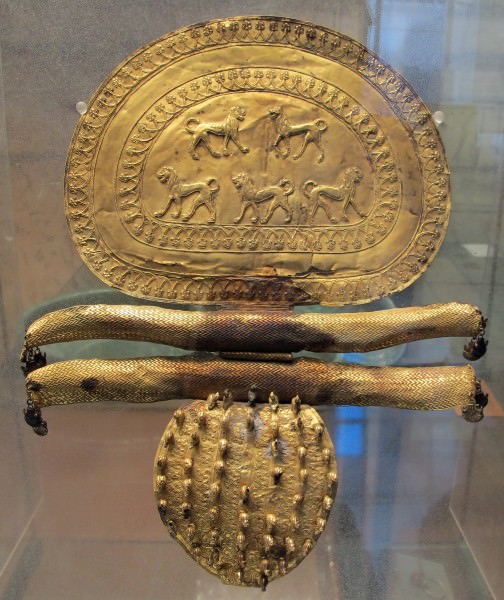
Etruscan Gold Fibula, Cerveteri
THE DISCOVERY
The Tomba Regolini-Galassi is named after the Italian priest Alessandro Regolini and the general Vicenzo Galassi, who discovered it in 1836 CE at the Sorbo necropolis just outside Cerveteri. The pair of amateur archaeologists had previously dug out five tombs from a huge earth mound north of the town, but all of them had been looted, and then their luck changed. Tomb number six was, miraculously, intact. Untouched for over two and a half millennia, it would be the most spectacular discovery in the region up to that time and the treasures within would fire the public imagination and create a whole new interest in the Etruscans.
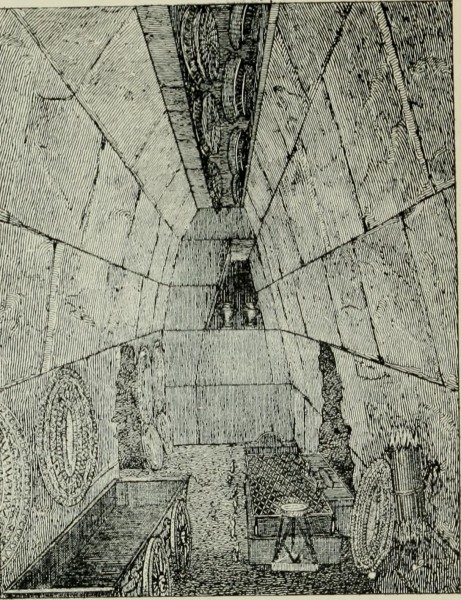
Regolini-Galassi Tomb Chamber
The rock-cut tomb takes the form of a long gabled rectangular corridor with two oval chambers, one on either side at the mid-point, and the main chamber at the end. Unfortunately for posterity, Regolini and Galassi were rather clumsy in their excavations. Entering the tomb from above, their digging caused the roof to collapse damaging some of the furniture inside. In addition, there was so much gold and precious goods inside that they mostly discarded any pottery finds.
ON ENTERING THE MAIN CHAMBER, REGOLINI & GALASSI CAME FACE TO FACE WITH THE SKELETON, BEDECKED IN FINE JEWELLERY, OF THE TOMB'S FEMALE OCCUPANT.
LARTHIA'S GOLD
On entering the main chamber, Regolini and Galassi came face to face with the skeleton, bedecked in fine jewellery, of the tomb's female occupant. She wore a gold pectoral 42 cm across decorated with hundreds of tiny animals and plants, a symbol of her high social, perhaps even royal, status. The woman also wore a belt with a magnificent gold fibula made with repoussé and granulation techniques. It is decorated with five lions on its upper disk and 50 minute ducks in three dimensions, arranged in seven rows on the lower disk which covers the pin. She wore two wide gold bracelets decorated with trios of dancing females with long hair and long dresses. Two necklaces are in gold, one with alternating round and elongated beads which are incised with lines, and the other with three large gold and amber pendants. Finally, there are gold earrings, spiral finger rings, and pins.
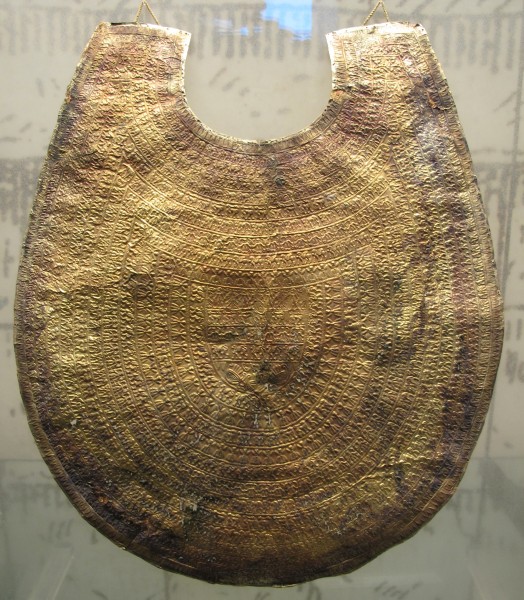
Gold Etruscan Pectoral
Whatever the role of this person was in life – certainly an aristocrat and likely a priestess, princess, or queen - we do know her name: Larthia, inscribed on each piece of an eleven-piece silver service set found at her feet. Neither was she interred alone in the tomb, for one of the side chambers contained the ashes of a male, set inside a pottery funerary urn in a wall niche. The second side chamber had no occupant (despite some early accounts of a third 'warrior' remains which has led to a repetition of the error in many sources ever since) but did have a quantity of silver gilt bowls.
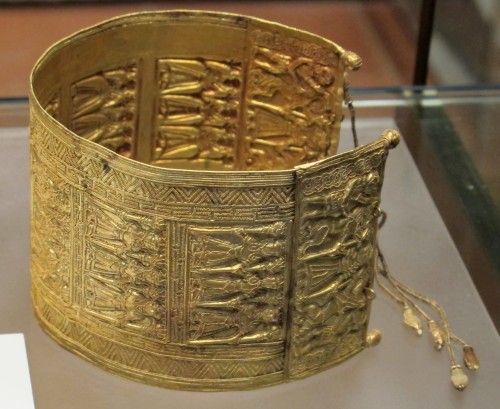
Gold Etruscan Bracelet
OTHER FINDS
Other items in the tomb, many with Near Eastern-like decoration include a large bronze latticework couch with six legs and a headrest; eight round bronze shields – some with molded panther heads with inlaid enamel eyes; bronze incense burners;cauldrons decorated with lion and griffin heads ( protomes ), and a throne with embossed lions, stags, and plants in the same material; silver cups, vases, and dishes; carved ivory boxes; and bucchero wares in the form of bowls, pitchers, beakers, and 33 grieving effigy figures. One bucchero bottle has a helpful complete Etruscan alphabet inscribed on its base. A magnificent gilded silver bowl is decorated with a lion hunt and procession of warriors and clearly indicates links with the Near East.Finally, there was a four-wheeled bed-carriage on which lay the woman of the tomb when she was in state and a two-wheeled chariot or biga which the Etruscans used for ceremonies and processions.
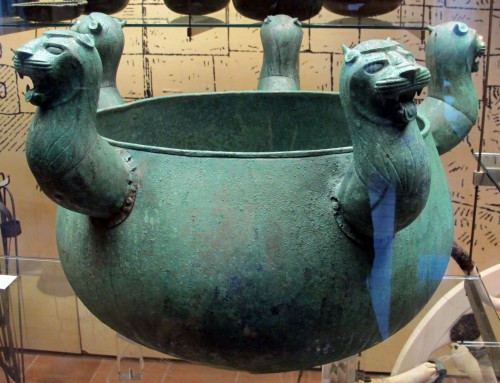
Etruscan Bronze Cauldron
More everyday items to metaphorically feed and amuse the deceased on their way to, or actually in, the next life include iron tools and several large terracotta vases which once contained foodstuffs such as wheat, oil, honey, and eggs. There was an ivory dice, and even a bronze stand with suspended disks used for the Greek drinking game of kottabos where drinkers tried to swish the slops from their wine cup at a target. The contents of the tomb can be seen today in its own dedicated room in the Museo Gregoriano Etrusco of the Vatican Museums, Rome.
See other Related Content for Ancient History ››
LICENSE
Article based on information obtained from these sources:with permission from the Website Ancient History Encyclopedia Content is available under License Creative Commons: Attribution-NonCommercial-ShareAlike 3.0 Unported. CC-BY-NC-SA License